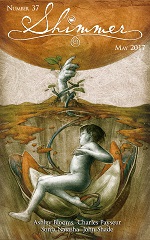“Fallow” by Ashley Blooms
Reviewed by Kevin P Hallett
There are four original short stories in this issue.
“Fallow” by Ashley Blooms
This is a short fantasy about a ten-year-old boy, William, living with his mostly absent mother in a trailer park. He strikes up a relationship with a younger girl. After playing spin the bottle with her, he buries the green bottle in the fallow field by the trailers. The next day a green glass statue begins to grow.
As his budding relationship evolves, William buries more items in the field, hoping to win his mother’s attention. Soon the field is almost full and crowds come to gawp and wonder at the strange evolving statues. But his mother’s loose life style troubles William. What can he plant in the fallow field to grab her attention forever?
The prose was easy to follow and the story interesting. But by the end, it was hard to root for William, a grey and underdeveloped character.
“Feathers and Void” by Charles Payseur
The crow-like spaceship and human entity, called Iv(y), is one of many that rampage together across space in this short SF tale. Attacking and scavenging space cruisers caught up in a brutal inter-planet war between human colonies is the setup. Authorities are hunting the murder of crows, and slowly their number dwindles.
When Iv(y) finds a mysterious orb, they believe it could provide a way to survival. The only person who can discern its true purpose is their creator, whom they all despise. When they free him from imprisonment, he reveals the orb’s power and a way they can cheat their inevitable fate.
This strange SF story was difficult to follow in places. The mystery it invoked came from its obscurity rather than a desire to discover what happens to the crows. A story that will appeal to some but turn off others.
“We Lilies of the Valley” by Sonja Natasha
Yvonne is alone on a space station in this short fantasy. The loneliness of her year-long assignment is more oppressive than she expects. Part of her job is collecting space debris to send to Earth for research. But she keeps some seed-like pebbles and even plants them, but, of course, they don’t grow.
When an Earth-bound stranger, Sierra, asks to be her Twitter-pal, Yvonne gladly accepts in the hope of breaking her dull routine. As a gift, Sierra sends her some water she has taken from a remote spring. After drinking some, Yvonne uses the remainder to water her space debris seeds. The seeds begin to grow, and a strange plant appears that is in tune with Yvonne’s feelings even as she and Sierra become ever closer friends. At the end of her shift, Yvonne wants to find a way to bring the plant down to the planet?
Despite a slow start, the mystery in this story kept the interest going. The prose was a little staccato, lacking an engaging flow. But in the end, the reader became entwined in the mystery of the plant’s rhythmic vines.
“Dandelion” by John Shade
Shade’s tantalizing short SF story has a group fleeing from AI nanomachines. Humanity’s hope lies with Leena, a member of the group, because she has the best ability and the other members sacrifice themselves for her chance to escape. As the nanomachines chomp-up the group’s members, their cells scatter and incorporate themselves in other objects.
Unable to measure time, they sense Leena’s return as a general. They become part of the weapons as the war to retake the planet from the nano’s wages on until finally humanity wins. Leena ages over time, as more and more cells from the old group drop off the grid.
A strange story that was hard to put down. Slowly the plot came together and each reader will have their own interpretation of what it all meant.
 Shimmer #37, May/June 2017
Shimmer #37, May/June 2017